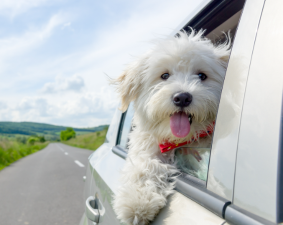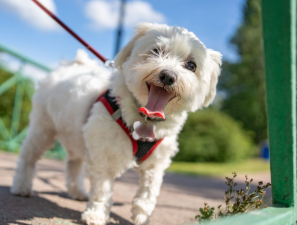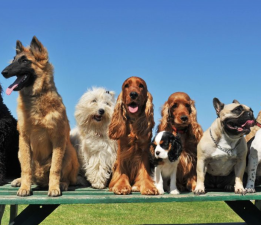St. Bernard, Blackback, Pointer, Great Dane, Giant Schnauzer and other large dogs. These dogs are used for snow rescue or military dogs. They can carry luggage and even drag people. They are relatively docile and loyal. They will not follow others just by touching them. They are more suitable for travel.


St. Bernard, Blackback, Pointer, Great Dane, Giant Schnauzer and other large dogs. These dogs are used for snow rescue or military dogs. They can carry luggage and even drag people. They are relatively docile and loyal. They will not follow others just by touching them. They are more suitable for travel.

[Travel Notes]
- Self-driving tour: This is the most suitable way for dogs to travel. First of all, you must be familiar with the route and know whether your dog suffers from motion sickness. Remember to put the dog in the back seat and keep it quiet; do not put the dog in the passenger seat to avoid distracting the owner and causing some unnecessary trouble. If you are driving on the highway, you can drive the car into the rest area during the journey. After all, dogs will get tired after sitting in the car for a long time. You must stop the car every few hours to let the dog urinate and defecate. At any time, do not leave the dog alone in a closed car! !
On days when driving for a long time, pay attention to slightly reducing the amount of food you feed in the morning. Prevent motion sickness or gastrointestinal discomfort caused by overeating. In the process of adapting to riding in a car, dogs will inevitably vomit in the car, which requires close observation by the owner. Usually, dogs will drool unnaturally before vomiting, which is a sign that they are about to vomit. It is best to have another owner who does not drive sit in the back seat and immediately raise the prepared plastic garbage bag and wait for it to vomit.
Dogs can usually adapt to motion sickness through training, and they cannot get used to it by vomiting. First, start with a short drive in the city for a few minutes, and then take a 1-2 hour ride in the suburbs to let it gradually adapt. Every time you take it out for a car trip, it is a happy trip after getting off the car, so that it will establish a connection between "riding in a car" and "happy play", so that it will not be afraid or bored from the heart.
- By plane: Determine the departure time and flight more than 3 days in advance. Some airlines need to go to the airport 2-3 days in advance to handle the check-in procedures for pets. In order to avoid the situation where the time is too tight and the procedures are wrong, the sooner the flight is determined, the better.
Call the corresponding airline to inquire whether the flight has an oxygen cabin and whether the pet can be checked in. There is no oxygen cabin on the plane, and the dog will be in danger of suffocation, so pets are not allowed. After confirming the flight, call the airport to inquire about the special requirements for bringing pets on board, what procedures need to be handled, and what certificates need to be issued. This step is very important. Once the owner neglects some of these issues, he may be denied boarding by the airport at the last minute.
Choose a vehicle for the dog. Each airport has different requirements for the cages for carrying pets on board. Some require that pets must be loaded in aviation boxes, some require that they must be loaded in cages with trays, and some also have clear regulations on size. In contrast, aviation boxes can make dogs feel more comfortable. You can put the dog's nest mat in the nest and put its favorite toys on it, so that the dog will not be too nervous.
Prepare various certificates. The certificates for bringing dogs on board mainly include immunization certificates, quarantine certificates, and cage disinfection certificates. The former is available for every dog, and the latter two depend on the specific regulations of each airport. Some require that they be issued at the local quarantine station, while others require that the pet and cage be brought to the airport for quarantine a few days in advance. The validity period of the quarantine certificate is usually only a few days. Be sure to ask clearly to avoid the certificate from expiring and becoming invalid.
Take the dog to the pet hospital and let the pet doctor determine whether the dog needs anesthesia to board the plane based on the dog's physique.
Bring all kinds of certificates and arrive at the airport more than 3 hours in advance. Do not feed the dog in the first few hours. When checking in, confirm again whether the flight has an oxygen cabin, because the airline sometimes changes the model temporarily. According to the relevant regulations for pet check-in, put the dog in a cage and take it to the baggage area for packing and weighing (pet check-in is considered oversized baggage check-in, and the airport charges a fee based on the corresponding weight).
- By train: You must have an animal quarantine certificate issued by an animal quarantine unit recognized by the railway department. Generally speaking, the cage for checking in dogs is required to be a steel structure, with a tray for feces under the bottom of the cage, or a sack or cotton mat tied to the bottom of the cage. The purpose is to prevent urine and feces from leaking and contaminating other goods. There need to be climbing hands on both sides of the cage for extraction (can be made of lead wire), and the cage opening needs to be tied with lead wire.
If you don't have a vaccination certificate, go to a nearby veterinary station at least one week in advance to get a rabies vaccine and obtain a vaccination certificate. One or two days in advance, take your pet and vaccination certificate to a nearby veterinary station for a physical examination and obtain a health certificate.
2-3 hours in advance on the day of departure, put the dog in a special aviation box and go to the cargo consignment station at the railway station to go through the consignment procedures. If the previous procedures are complete, as long as you show the vaccination certificate, exit quarantine certificate and ticket, you can get a form to fill out, weigh, and pay the fee. After completing the consignment, the owner must accompany the pet until he enters the cargo compartment with the pet to settle the dog, and then go back to his own compartment to rest. After getting off the train, go to the arrival station to pick up the dog with the bill of lading.

[Special attention]
You must first contact the destination hotel and get a definite reply before you can take the dog there, and you must ensure that your dog will not disturb the guests' rest or the normal business order of the hotel. Of course, you must do these guarantees. According to my experience, the farther away from the city center, the easier it is to accept; small and medium-sized cities are easier to accept than metropolises; the higher the star rating of the hotel, the less likely it is to accept. Most resorts in scenic spots, 2-3 star hotels, and inns are mostly acceptable.
If you encounter a hotel that refuses pets, communicate patiently, and most of them will be allowed to stay in the end. Here, dog owners need to consciously abide by the regulations, consciously avoid guest elevators, take the staff stairs, and choose rooms on lower floors. Don't let dogs urinate and defecate in hotel rooms, and don't use hotel guest towels to wipe dogs, as hair will fall on them. . .
- Put a leash on your dog and walk around the elderly and children.
- When taking pictures of your dog, don't turn on the flash.
- Don't go into roadside souvenir shops and restaurants, etc.
- Don't stay on the beach for too long. The sand will wear out the dog's foot pads to a certain extent, and excessive stay will cause bleeding spots.
- If you can't control the dog, don't loosen the leash and let it go to the sea by itself. Don't let it eat some things on the beach. These fishy smells may attract dogs, so pay special attention.
- After the dog goes to the sea, when it returns to the hotel, it is necessary to wash off the salt remaining on the dog's skin to avoid skin damage. After the dog comes ashore, the owner must not wipe it dry with a towel, otherwise the wet coat will be easily caught by the sea breeze.
- Before taking the dog to climb the mountain, spray insect repellent on the dog's skin to keep it away from mosquito harassment and reduce the chance of infectious diseases. This is very important because many diseases (such as babesiosis) are transmitted by mosquito bites. In addition, carry pet hemostatic powder with you, so there is no need to panic when bleeding accidents occur.
- The prairie is most suitable for dogs who like to run, but dogs may also get lost on the prairie, so the owner must control the dog within the designated range to prevent the dog from getting lost or running into the prairie area of other herders. Many herders have dogs at home, but most of the dogs there take it as their responsibility to guard the house. When they meet strangers, they will bark or even bite. If your dog is also aggressive, you must tie it up to avoid conflicts with local dogs.
- Some grasslands are high in terrain, with long sunshine hours and strong light. For example, when taking your dog to the Inner Mongolia grassland, you should pay attention to sun protection, or avoid traveling during the intense sunshine. The temperature difference between morning and evening on the grassland is large, so it is very necessary to bring some warm clothes for your dog. Most of the drinking water on the grassland has a high salt and alkali content. If you are worried that your dog will have difficulty adapting, you can prepare some mineral water for it.
- Dogs are not suitable for eating human food. In order to allow dogs to adapt to the local water and soil as soon as possible, the amount and time of feeding the dog should be as close as possible to usual. In addition, don't forget to bring the puppy's favorite snacks. When going out, there are always situations where the dog is out of control. At this time, delicious snacks can make the dog obey the command at all times.
- During the journey, there will always be accidents of one kind or another. The owner should carry regular medicines with him, such as gastrointestinal medicines, insect repellents, etc. If conditions permit, you can also bring pet sunscreen sprays, and you can also consult the pet doctor about which specific medicines to bring.



